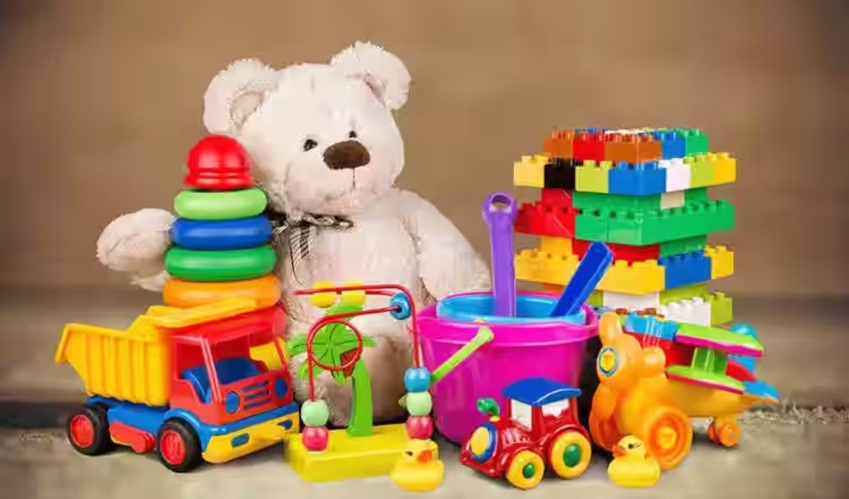Europe Toys Market Outlook
The Europe toys market reached a value of approximately USD 14.51 billion in 2024. Aided by the rising demand for educational and interactive toys, as well as the continued evolution of children’s entertainment preferences, the market is projected to grow at a CAGR of 2.70% between 2025 and 2034, reaching nearly USD 18.94 billion by 2034.
The toys industry in Europe is one of the most dynamic segments within the broader consumer goods sector. It is supported by evolving consumer lifestyles, growing child population across key European economies, and the continual emergence of popular content franchises. From traditional toys such as dolls and action figures to high-tech toys and games integrated with augmented reality and artificial intelligence, the European market reflects a balance between heritage brands and modern innovation.
Toys play a vital role in a child’s developmental journey, fostering imagination, creativity, motor skills, and problem-solving abilities. As parents become more conscious of the impact of play on cognitive and emotional development, the demand for high-quality, educational, and safe toys has significantly increased. This shift is positively influencing the European toys market, encouraging manufacturers to deliver a diversified and value-driven product portfolio.
Europe Toys Market Size
The Europe toys market has expanded considerably over the past decade, primarily fuelled by growing disposable incomes and increasing awareness regarding developmental benefits associated with educational and constructive play. With technological advancements and the widespread influence of digital media, children across the region are increasingly exposed to global entertainment content, which often translates into merchandise demand, particularly character-based toys and themed playsets.
In 2024, the market size reflected strong contributions from countries such as Germany, France, the United Kingdom, Italy, and Spain. These regions have well-developed retail infrastructures and house several prominent manufacturers and distributors. Furthermore, online platforms and specialty toy stores have contributed to market accessibility and convenience, further enhancing the size and scale of the market.
Despite being a mature market, Europe continues to demonstrate consistent growth due to periodic innovations, premiumisation of products, and enhanced marketing strategies that target both children and parents. As consumers increasingly seek toys that combine entertainment with learning, the market is set to continue expanding in both value and volume terms.
Receive a detailed report, including the Table of Contents – https://www.expertmarketresearch.com/reports/europe-toys-market/requestsample
Europe Toys Market Share
Germany currently holds a leading share in the Europe toys market, supported by a strong domestic manufacturing base, a high standard of living, and robust spending on children’s education and entertainment. The German market also benefits from consumer inclination towards eco-friendly, durable, and quality-certified products.
The United Kingdom and France follow closely, driven by high toy consumption levels and a thriving retail and e-commerce ecosystem. The UK market, in particular, is highly trend-sensitive, often leading the adoption of globally popular licensed toys and digital games.
The Scandinavian countries, though smaller in size, hold a notable share due to their preference for educational, STEM-based, and wooden toys that align with environmental and developmental values. Meanwhile, Eastern European countries are emerging markets with increasing urbanisation, growing middle-class population, and rising exposure to international toy brands, offering untapped potential for market expansion.
Europe Toys Market Trends
Rise in STEM and Educational Toys: One of the most prominent trends in the Europe toys market is the growing demand for toys that promote Science, Technology, Engineering, and Mathematics (STEM) learning. Parents and educators increasingly favour products that encourage problem-solving, creativity, and logic. Toys such as building kits, coding robots, and interactive science kits are gaining popularity across classrooms and homes alike.
Digital Integration and Smart Toys: The proliferation of smart devices has influenced the development of toys that incorporate augmented reality (AR), artificial intelligence (AI), and app-based functionalities. Children’s play patterns have evolved to include interactive features, and toymakers are adapting by designing products that blend physical play with digital engagement.
Sustainability and Eco-Conscious Manufacturing: Sustainable production is becoming an industry-wide priority. There is growing demand for toys made from recycled materials, biodegradable plastics, or sustainably sourced wood. Several manufacturers are rethinking packaging and design to reduce environmental impact and align with Europe’s broader sustainability goals.
Popularity of Licensed and Character-Based Toys: Entertainment franchises continue to shape toy trends across Europe. With popular television shows, movies, and online content influencing young audiences, toys featuring licensed characters remain highly sought after. Collaborations between toy companies and entertainment studios help maintain relevance and drive sales.
Inclusive and Gender-Neutral Toys: There is a growing push towards inclusivity in toy design, with increasing availability of gender-neutral, multicultural, and disability-inclusive toys. This trend aligns with societal changes and parental demand for toys that reflect diversity and promote empathy and inclusiveness.
Drivers of Growth
High Parental Spending and Gifting Culture: Toys remain a preferred category for birthdays, holidays, and educational gifting. Parents and grandparents across Europe allocate a significant portion of discretionary income to children’s products, with a strong emphasis on meaningful and value-rich play experiences.
Technological Innovations and Toy Tech: As technology becomes more accessible, it enables the development of sophisticated and engaging toys. From voice-activated dolls to app-controlled drones, innovation is a critical factor sustaining consumer interest and encouraging product upgrades.
Strong E-Commerce and Omnichannel Retailing: Online retailing has emerged as a major growth driver, offering convenience, extensive variety, and ease of comparison. The integration of digital tools such as virtual try-ons, video demos, and AR filters further enhances customer experience and boosts conversion rates.
Educational System Collaboration: Collaborations between toy manufacturers and educational institutions or curriculum developers are providing new channels for toy adoption. Toys designed for classroom use or homeschooling support are growing in popularity, contributing to demand stability.
Expansion into Adult Toy Markets: A growing number of toy brands are catering to adult consumers, tapping into nostalgia and offering collectibles, puzzles, and games targeted at young adults and grown-ups. This niche but expanding segment is adding a new dimension to the Europe toys market.
Europe Toys Market Segmentation
The market can be divided based on product, by age group, distribution channel and region.
Market Breakup by Product
- Action Figures
- Building Sets
- Games and Puzzles
- Dolls
- Sports and Outdoor Toys
- Plush
- Others
Market Breakup by Age Group
- Up to 5 Years
- Between 5 to 10 Years
- Above 10 Years
Market Breakup by Distribution Channel
- Hypermarkets and Supermarkets
- Departmental Stores
- Online Channels
- Others
Market Breakup by Region
- Germany
- United Kingdom
- France
- Italy
- Spain
Industry Key Players
Some of the major players explored in the report by Expert Market Research are as follows:
- LEGO System A/S
- Hasbro, Inc.
- Mattel, Inc
- Clementoni Spa
- The Goliath Games LLC and B.V Companies
- Ravensburger Group
- Thames & Kosmos
- BRUDER Spielwaren GmbH + Co. KG
- Abysse Corp
- Steiff Retail GmbH
- Others
Challenges and Opportunities
Challenges: Despite its strengths, the Europe toys market faces several challenges. Regulatory compliance is one of the most significant, as manufacturers must adhere to stringent safety and environmental standards across the EU. Navigating these regulations increases production costs and time to market.
Rising raw material and logistics costs, particularly in the post-pandemic global landscape, also affect profitability. Moreover, intense competition from low-cost imports and counterfeit products can impact the credibility of established brands and undercut market pricing.
Digital screen time is another challenge, as the growing preference for smartphones, tablets, and video streaming among children may reduce traditional toy engagement, especially in older age groups.
Opportunities: Innovation and brand collaboration offer vast opportunities for growth. Strategic partnerships with ed-tech companies, content creators, and sustainability-focused startups can open up new product categories and consumer segments.
The rise of experiential retail, where toy stores offer immersive play experiences and in-store activities, presents retailers with the chance to differentiate themselves and create brand loyalty. Moreover, expanding into underserved demographics, such as special needs children or emerging Eastern European markets, can provide fresh avenues for long-term growth.
Customisation and personalisation of toys, supported by digital tools and direct-to-consumer channels, also present an exciting opportunity. These features enhance emotional connection and are especially effective in premium product categories.
Europe Toys Market Forecast
Looking forward, the Europe toys market is expected to maintain a steady growth path, supported by continuous innovation, growing awareness of educational benefits, and rising sustainability consciousness. Between 2025 and 2034, the market is projected to grow at a CAGR of 2.70%, reaching a value of approximately USD 18.94 billion by 2034.
The forecast remains positive due to increasing parental investment in quality play, expansion of digital-physical hybrid toys, and the ongoing development of inclusive and environmentally responsible products. The future of the market lies in its ability to balance tradition with technology, education with entertainment, and sustainability with creativity.
As manufacturers, retailers, and educators continue to align their efforts towards delivering safe, engaging, and developmental toys, the Europe toys market is well-positioned to thrive across the coming decade.
Read Our Trending Reports:
India Caustic Soda Market: https://www.expertmarketresearch.com/reports/india-caustic-soda-market
Recovered Paper Market: https://www.expertmarketresearch.com/reports/recovered-paper-market
Bunker Fuel Market: https://www.expertmarketresearch.com/reports/bunker-fuel-market
PropTech Market: https://www.expertmarketresearch.com/reports/proptech-market
Media Contact:
Company Name: Claight Corporation
Email: sales@expertmarketresearch.com
Toll Free Number: +1–415–325–5166 | +44–702–402–5790
Address: C-130 Sector 2 Noida, Uttar Pradesh 201301
Website: https://www.expertmarketresearch.com





